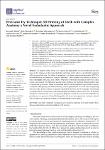Print and Try Technique: 3D-Printing of Teeth with Complex Anatomy a Novel Endodontic Approach
| dc.contributor.author | Tonini, R | |
| dc.contributor.author | Xhajanka, E | |
| dc.contributor.author | Giovarruscio, M | |
| dc.contributor.author | Foschi, Federico | |
| dc.contributor.author | Boschi, G | |
| dc.contributor.author | Atav-Ates, A | |
| dc.contributor.author | Cicconetti, A | |
| dc.contributor.author | Seracchiani, M | |
| dc.contributor.author | Gambarini, G | |
| dc.contributor.author | Testarelli, L | |
| dc.contributor.author | Pacifici, L | |
| dc.date.accessioned | 2023-05-05T11:56:41Z | |
| dc.date.available | 2023-05-05T11:56:41Z | |
| dc.date.issued | 2021-02-02 | |
| dc.identifier.issn | 2076-3417 | |
| dc.identifier.issn | 2076-3417 | |
| dc.identifier.other | 1511 | |
| dc.identifier.uri | https://pearl.plymouth.ac.uk/handle/10026.1/20827 | |
| dc.description.abstract |
The purpose of this report is to evaluate the applicability of a novel Print and Try technique in the presence of aberrant endodontic anatomies and to achieve a predictable treatment with improved outcome. According to guidelines, cone beam computed tomography (CBCT) is recommended in the presence of complex anatomies. The volumes were utilized to produce a stereo lithographic (STL) file, from which a 3D-plastic tooth model including a hollow root canal system was obtained. The 3D-patient-specific model facilitates the treatment planning and the trial of therapeutic approaches. Using a transparent material, all the treatment steps could be directly visualized. Subsequently, endodontic therapy could be performed in vivo with reduced operating time and with a better overview. Clinicians benefit from the Print and Try technique when facing a complicated root canal system with reduced stress and higher chances of success. In aberrant endodontic anatomies, the use of a transparent 3D plastic model, derived from the CBCT dicom, provides an exact preview of clinical challenges that will be met intra-operatively. A patient centered tailored approach to shaping, cleaning, and filling strategies can be applied. | |
| dc.format.extent | 1511-1511 | |
| dc.language | en | |
| dc.publisher | MDPI AG | |
| dc.title | Print and Try Technique: 3D-Printing of Teeth with Complex Anatomy a Novel Endodontic Approach | |
| dc.type | journal-article | |
| dc.type | Journal Article | |
| plymouth.issue | 4 | |
| plymouth.volume | 11 | |
| plymouth.publication-status | Published online | |
| plymouth.journal | Applied Sciences | |
| dc.identifier.doi | 10.3390/app11041511 | |
| plymouth.organisational-group | |Plymouth | |
| plymouth.organisational-group | |Plymouth|Faculty of Health | |
| plymouth.organisational-group | |Plymouth|Users by role | |
| plymouth.organisational-group | |Plymouth|Users by role|Academics | |
| plymouth.organisational-group | |Plymouth|Faculty of Health|Peninsula Dental School | |
| dcterms.dateAccepted | 2021-02-04 | |
| dc.date.updated | 2023-05-05T11:56:17Z | |
| dc.rights.embargodate | 2023-8-16 | |
| dc.identifier.eissn | 2076-3417 | |
| dc.rights.embargoperiod | forever | |
| rioxxterms.versionofrecord | 10.3390/app11041511 |


